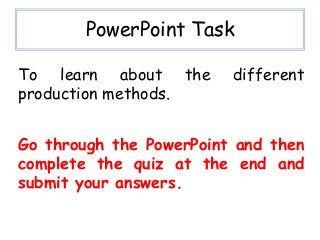
Production Methods
- 1. PowerPoint Task Go through the PowerPoint and then complete the quiz at the end and submit your answers. To learn about the different production methods.
- 3. One-Off •One-off or individual production, is used to manufacture one-off products. •It is often related to as “tailor made”, bespoke or customised solutions. •A key feature is often a high-cost product that is manufactured to a client specification. •This kind of one-off product may be higher cost due to more expensive materials and time consuming hand crafted production and finishing. • Wedding dresses and custom made pieces use this type of manufacture. • This is the most expensive type of manufacture. • Highly skilled workers will be used, and will work on one job at a time. This means that it is extremely expensive.
- 4. •Batch production is used to identical products in specified, predetermined “batches”. •It can vary from tens to thousands of products. •A key feature is the flexibility of the tooling, machinery and workforce to enable fast turnaround of products. •This can easily be adapted to manufacture different products. •Batch production often makes use of flexible manufacturing systems (FMS) to enable companies to be competitive. •Batch production results in lower unit cost than one off production. •More likely to be used for seasonal goods or products with a fixed life. • Batch production will be used by high-street retailers as fashion changes so frequently • Things like: Home interior products (inspired by a trend), decorated dresses and fashion items Batch
- 5. Mass •Mass products are produced in HIGH volume •Mass production makes use of efficient automated manufacturing processes and a largely unskilled workforce. •Mass produced products are designed to follow mass market trends, so the product appeals to a wide national and international target market. •Production planning and quality control (QC) enables the manufacture of identical products. •Production costs are kept as low as possible so that the product will provide value for money. •Mass products will include things like, pens, pencils, electronic products, and many more every day items. • It is a cheap method of production because materials can be bought in large numbers and a large number can be made quickly.
- 6. Continuous Production •Continuous production is used to manufacture standardised mass-produced products that meets every day mass-market needs. •Production will run 24 hours a day, 7 days a week, 365 days a year. •Continuous production is used to make products that are always needed and never change. •This type of production is highly automated and uses machines that can run continuously for long periods of time with breaks only for maintenance • Used for drinks bottles, cans, wine bottles, egg boxes, petrol. (Any product that you can think off that is constantly being used in the masses) • More likely to manufacture products in their millions
- 8. Complete the Quiz!! Now you have been through the PowerPoint you can complete the quiz. Make sure you work as a team. If you are stuck on a question you can have a look back at the PowerPoint for the answers. Click me to take the Quiz...
- 9. If you complete the Quiz and still have time left. Write down some questions that can be used for Year 7 IS. Remember the harder they are, the better: • Write your questions with answers below: Name 5 ways that batch products are used and why.